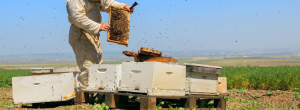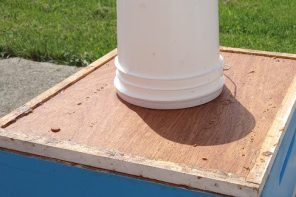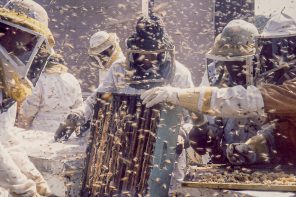Master Insights on Splitting a Hive
By: Earl Hoffman
The art of beekeeping is all about timing, so it may come as no surprise that there is a critical two-week window when splitting a hive. Starting too early – before nectar and pollen is flowing – puts the hive at risk for chilled brood and starvation. Starting too late – when the bees are feeling they have outgrown their home – puts the hive at risk for a swarm. Master beekeepers Earl and Carol Hoffman have the following ideas to consider on your beekeeping quest.
 Signs it is Time to Split
Signs it is Time to Split
You can have your timing down but accomplishing the tasks will depend on the weather. Sometimes, a late frost or weeks of cold rain will delay the opportunity to split your hives. Earl and Carol use the Spring bloom of dandelion flowers as a marker for making splits.
If a hive is strong in the Spring, it is a great candidate for pulling brood frames to help in the splitting process. During a Spring hive inspection, if you see queen cells located on the bottom of the brood frames, it could be an indication the hive is preparing to swarm. Hives that are on the verge of swarming should be split. When bees feel they have outgrown their hive, they will leave in an attempt to establish a new one themselves.
Split Sizes
Splits can be many sizes, from large double-deep supers and five-frame nucleus hives, all the way down to the Summer two-frame deep split. The size of the split will be dependent on the amount of nurse bees in the hive – they are needed to keep the brood warm.
The size of the split will also depend on timing and weather. In Spring, when overnight temperatures are above freezing, splits need to be large and full of bees, pollen and honey. In early Summer, when overnight temperatures remain above 50°F, splits can be as small as two frames of deep comb: one frame of pollen and honey, one frame of capped brood and lots of nurse bees to keep it warm.
The Art of Splitting
Earl and Carol have said before that beekeeping has one thousand inputs and one thousand outputs. When working within the critical two-week window available to split a hive, consider the following practices to increase your chances of success:
- Drawn comb is the beekeeper’s golden treasure. Guard the wax comb and use it to make your splits and nucleus (nuc).
- There needs to be similar amounts of bees, brood and food in each super between the original hive and the split hive.
- Take extra care when moving frames with queen cells so they are not damaged. Queen cells should be used to your advantage – they are a gift from the bees.
- Frames of honey normally would be on the outside positions of the hive, and the pollen frame next to the brood in the center of the super.
- Nucs consist of a smaller size super with five deep or medium frames. Nuc boxes are easy to make. You can use scrap wood to make a bottom, four sides and a lid cut to size, and glue and nails for lap joints. Cut a ¾ inch hole for the hive entrance.
- If you are overwintering double deep supers, the task is simple: separate the two deep supers and install the new queen or queen cell into the queenless split.
- Use entrance reducers with each split and give bees access to a feeder for thin bee syrup, one to one is fine.
- Earl and Carol do not recommend the use of plastic or wax foundation frames with new splits. Let the bees focus on caring for the young and not creating wax comb. These frames are best to be drawn out by a strong hive brimming with bees during a nectar flow.
In Case of Swarm
If you miss the window to split a strong hive and it swarms, you can act fast to bring the bees back. An excellent way to attract swarm scout bees is to place bait comb boxes in trees and other accessible areas. Older dark comb will help most in capturing the swarm. Lemon grass oils or swarm capture attractants can also be effective. If swarms are at the ground level, supers with drawn comb can capture them if access to the comb is given.
Earl and Carol do not recommend using plastic or wax foundation frames to attract a swarm. However, plastic or wax foundation frames are effective with a captured swarm that did not find a bait hive. Place the swarm in the super with foundation. The workers will have no brood to feed, so all the swarm energy will go into comb creation.
Approach hive splitting like everything else in beekeeping. Leverage every tool in your toolbox – from your tried-and-true practices to new ideas. All learnings play a role in helping you achieve your desired results. It is a grand endeavor indeed.








